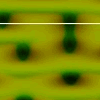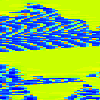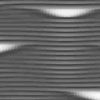

Figures
Click for full size and caption.




Complex systems consist of parts that interact with each other in a non-trivial (non-linear) way, like coupled neurons in the brain, like spatially distributed interacting ecological species, or like the ice-ocean-atmosphere coupling in the climate system. Such systems are often very sensitive to perturbations as obvious in smoke patterns of a cigar, in turbulent patterns of a fluid, in the fibrillation state of the heart immediately before sudden cardiac death, or in spatially and temporally irregular (chaotic) chemical reactions. Some of these complex systems - very counterintuitively - can suddenly go extinct. This is like a smoke pattern suddenly disappearing, or an ecological species suddenly going extinct. If such drastic changes happen to a system, we usually look for an external influence - like a strong predator - that causes such a spontaneous system collapse. New research shows that some systems can drastically change their behavior without any external influence. Systems develop by themselves into a critical state from where they suddenly collapse. How can a system live for a long time, obey statistically asymptotic behavior, and then suddenly change its behavior without warning? This is like a billiard ball irregularly bouncing around on a frictionless table for many many months until the ball suddenly escapes through a tiny hole. Finding and quantifying such critical holes in a mathematical space is crucial to the understanding of sudden collapses in nature, like the instantaneous stop of a chemical reaction, the extinction of ecological species, or the understanding of projected drastic regime changes in the (Arctic) climate system. Currently it is mathematically not understood which systems undergo such collapses, i.e. which systems have such critical holes from where they can escape instantaneously into a new behavior. The images to the right depict simulations of four such systems (please click on them for more information). In all of these systems the time of the collapse is not predictable in advance of the collapse.
This research is based upon work supported by the National Science Foundation under grant number PHY-0653086, and by the Arctic Region Supercomputing Center at the University of Alaska Fairbanks.
V Kaminker (PhD student) and R Wackerbauer, Alternating activity patterns and a chimeralike state in a network of globally coupled excitable Morris-Lecar neurons, Chaos 29, 053121 (2019).
H Hartle (undergraduate student) and R Wackerbauer, Transient chaos and associated system-intrinsic switching of spacetime patterns in two synaptically coupled layers of Morris-Lecar neurons, Phys. Rev. E 96, 032223 (2017).
J Lafranceschina (MS student) and R Wackerbauer, Impact of weak excitatory synapses on chaotic transients in a diffusively coupled Morris-Lecar neuronal network, Chaos 25, 013119 (2015).
K Keplinger (MS student) and R Wackerbauer, Transient spatiotemporal chaos in the Morris-Lecar neuronal ring network, Chaos 24, 013126 (2014).
D Stahlke (MS student) and R Wackerbauer, Length scale of interaction in spatiotemporal chaos, Phys. Rev. E 83, 046204 (2011).
D Stahlke (MS student) and R Wackerbauer, Transient spatiotemporal chaos is extensive in three reaction-diffusion networks, Phys. Rev. E 80, 056211 (2009).
R Wackerbauer, Master stability analysis in transient spatiotemporal chaos, Phys. Rev. E 76, 056207 (2007).
R Wackerbauer and S Kobayashi (undergraduate student), Noise can delay and advance the collapse of spatiotemporal chaos, Phys. Rev. E 75, 066209 (2007).
S Yonker (MS student) and R Wackerbauer, Nonlocal coupling can prevent the collapse of spatiotemporal chaos, Phys. Rev. E 73, 026218 (2006).
R Wackerbauer and K Showalter, The collapse of spatiotemporal chaos, Phys. Rev. Lett. 91, 174103 (2003).